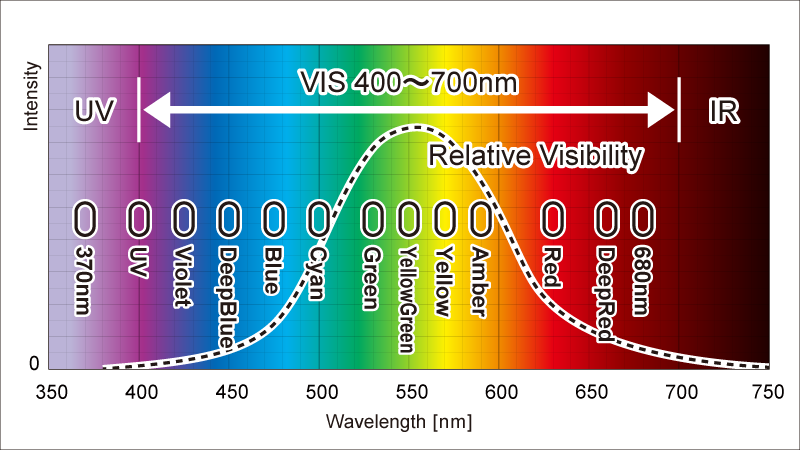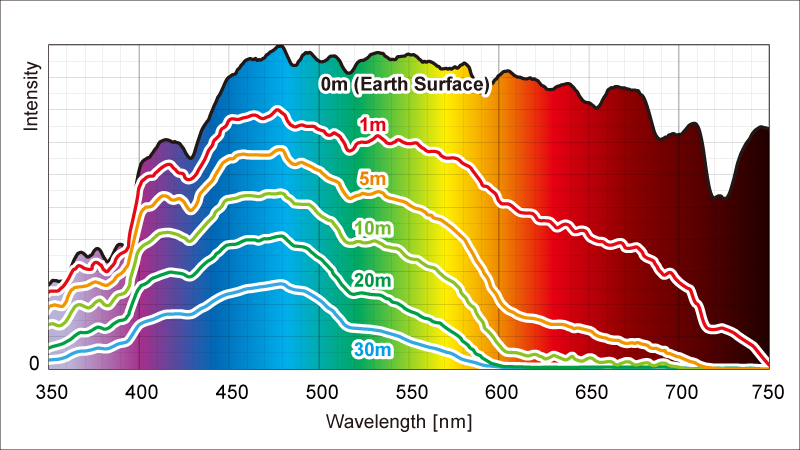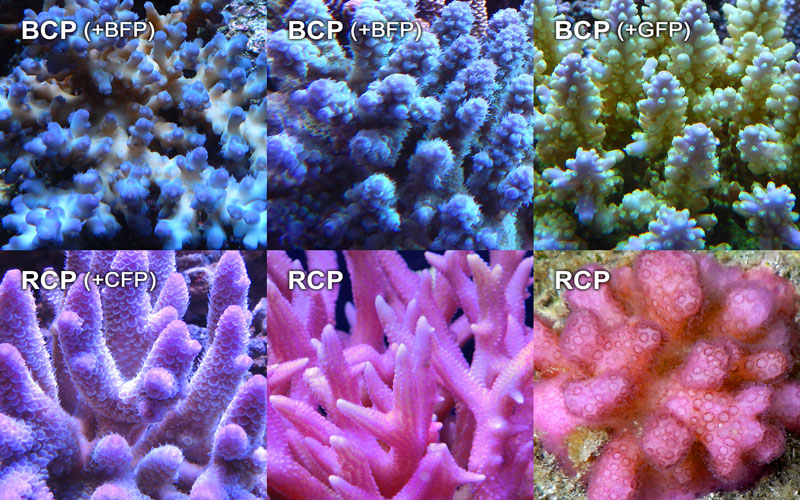Keep-Reef LED Series, from JAPAN
Special LED lights for aquarium facilities and research institutions
to properly color management and nurture corals in a healthy way!
Coral Color Management
This is a coral color management theory created by scientifically understanding the color of coral from an optical perspective!
Coral Color Management lecture by EIJI MYORIN of 1.023world, who designed and developed SPECTRA and VitalWave.
1. Coral and Light Basics
1-1. The Relationship between Wavelength and Color

Visible light (the wavelengths visible to the human eye) is between 400-700nm, with short wavelengths (low) on the left and long wavelengths (high) on the right. The color order, from left to right, are; Ultra Violet (UV, below 400nm), Violet, Deep Blue, Blue, Cyan, Green, Yellow Green, Yellow, Amber, Red, and Deep Red. This is same as the order of color arrangement from inside to outside of the rainbow. On the right side, above 700nm, is Infrared.

The energy of ray is stronger in single wavelengths than in longer wavelengths. Because the human eye has a specific visual sensitivity (Relative Visibility), the intensity of light is perceived differently depending on the color. For example, 555nm of green light is felt most intensely, while blue and red light is only about one-tenth of that.
1-2. Sun Spectrum and Underwater Spectrum

Sunlight contains an almost uniform amount of visible light from 400-700nm, but UV (below 400nm) are slightly weaker.
Visible light in the 400-700nm range of sunlight is almost uniformly contained, and UVs below 400nm are also present at about 30-40% of the intensity of visible light.
There are three types of ultraviolet rays: UVC/UVB/UVA. Ultra violet C (UVC -200-280nm),
attenuates in the atmosphere and does not reach the ground,
UVB (280-320nm: the cause of sunburn) reaches the surface of the earth but attenuates in water
and is not present in the sea and UVA (320-400nm) is the only type of ultraviolet radiation in the sea.
And, in transparent waters, the UV intensity in the ocean is so high that UVA can reach as deep as visible light.
In addition, under the sea, wavelengths above 600nm are greatly attenuated, and at depths below 10m,
red light becomes virtually nonexistent.
See the movie to actually measure the bathymetric spectrum and PPFD (photosynthetic photon flux density) in the reef.
The depth spectrum shows that the majority of the red wavelength is lost even at a depth of only 4 meters.
However, the UV light arrives unattenuated in the same way as the blue light.
Note that in the real ocean there is a tidal range of up to 3m tidal range, so for example, corals living in 5m depth at high tide are bathed in a spectrum of 2m depth at low tide.
1-3. Types of Chlorophylls (Photosynthetic Pigments)

The absorption spectrum is a graph showing the required (absorption) and unwanted (reflection) wavelengths.
Using Chlorophyll c as an example, the wavelength around 450nm can be interpreted as absorbing (using) the most and reflecting (not using) the other wavelengths.
Also, the reflected wavelengths represent the color rendering of the dye, so Chlorophyll c appears yellow (green + red).
Chlorophyll a and chlorophyll b are the main photosynthetic pigments of terrestrial plants.
Chlorophyll c is a photosynthetic pigment possessed by zooxanthellae and diatoms that absorbs the deepest blue light around 450nm and requires little deep red light.
Since corals (zooxanthellae) have either or both a and c Chlorophylls, corals with c do not need deep red light, but corals with only a must also be exposed to deep red light in order for photosynthesis to occur normally.
Chlorophyll d is a photosynthetic pigment possessed by bacteria.

Incidentally, you can observe chlorophyll from familiar sources. For example, you can extract chlorophyll by dissolving powdered tea or dried sea lettuce in alcohol. And since chlorophyll has Chlorophyll Fluorescence, you can observe it glowing red when exposed to a UV light.
1-4. Zooxanthellae Absorption Spectrum

The absorption spectrum of zooxanthellae is the combined spectrum of each photosynthetic dye. Since it absorbs UV to Cyan light and Deep Red wavelengths of around 670-680nm, it has a reddish-brown appearance.
Carotene/fucoxanthin/peridinin is a type of carotenoid that functions as an auxiliary pigment for photosynthesis and is mainly brown (orange/brown/red) in color.
Chlorophyll a and peridinin emit fluorescence at a deep red wavelength of around 680nm when exposed to strong light (photosynthetic excess light levels), which is thought to be recycled for chlorophyll a photosynthesis.
Chlorophyll fluorescence by microalgae and coralline algae reacts to UV light on live rock at night in a red-black color. (but the bright red luminescence is due to the red fluorescent protein RFP of the limestone algae.)

The coral transfers nitrogen and phosphorus taken in from the sea to the zooxanthellae, and the zooxanthellae use the photosynthetic pigments and auxiliary pigments mentioned above to conduct photosynthesis and transfer the energy generated to the coral.
The color of zooxanthellae is generally seen as brown. And the green pigment that is visible through the interior of the zooxanthellae is chlorophyll a. Can you see it?
2. Knowledge required for Coral Color Management
2-1 Spectrum of Fluorescent Proteins

Fluorescent proteins emit light in the emission spectrum (solid line) when exposed to an excitation wavelength (dashed line). The peak excitation wavelength is the maximum emission wavelength.
Fluorescent proteins are abbreviated as FPs, and if you assign the first letter of each color to them, they are BFP (Blue Fluorescent Protein), CFP (Cyan Fluorescent Protein), GFP (Green Fluorescent Protein), and RFP (Ped Fluorescent Protein).
A luminescence spectrum is simply a curve of the intensity of emission wavelengths, while an excitation wavelength curve is a line connecting the intensity points of the peak wavelengths emitted at each of the excitation wavelengths, applied in sequence by 1nm.
Taking RFP as an example, the excitation wavelength is applied in sequence from 350nm, and at first the emission spectrum becomes the emission intensity of B when it approaches 450nm at point B1, then at 500nm at excitation wavelength A, the emission spectrum reaches the maximum intensity of A, and then at 530nm at excitation wavelength B2, the emission spectrum again becomes the emission intensity of B. Thus, the left end of the excitation wavelength curve is the "starting wavelength" and the right end of the excitation wavelength curve is the "de-emission limit wavelength".


Now that you understand how to interpret the excitation wavelengths of fluorescent proteins,
look again at the above graph.
It can be interpreted that coral fluorescent proteins come in a variety of emission colors, such as BFP, CFP, GFP, and RFP,
and that each fluorescent protein requires a different wavelength range.
(Generally, wavelengths 50-100nm shorter than the emission color required.)
Therefore, BFP/CFP requires UV around 400-420nm, GFP requires blue light, and RFP requires blue or green light.
Thus, a sufficient wavelength intensity in the range of 400-500nm is required to fully excite
and emit all the fluorescent proteins in a coral.
This all fluorescent protein excitation band is referred to as "Wide-Band-Blue".

Just to be sure, we show you the data that validate the need for Wide-Band-Blue.
This is an excitation spectrum calculated based on the measured spectra of each fluorescent protein.
This measurement and calculation requires special equipment and techniques.
In conclusion, the general blue light was sufficient for the excitation of GFP/YFP/RFP,
but the UV band of 400-430nm proved to be essential for the excitation of BFP/CFP.
Therefore, we have to create a photonic environment with Wide-Band-Blue to adequately accommodate
the various fluorescent proteins of the reef.

However, until now, the importance of UV has not been well known, as only GFP and RFP were recognized by the public as fluorescent colors in corals. In addition, UV-LED emitters are very expensive and can melt the lens if not carefully product designed, so aquarium makers have not been very active in adopting UV-LED emitters. As a result, the general aquarium LED products, only blue light of 450nm is very strong and UV light is very weak.
Then, to ensure Wide-Band-Blue, you need to adjust your LED light's 5 channels (UV 400nm/Violet 420nm/DeepBlue 450nm/Blue 470nm/Cyan 500nm) to the same wavelength intensity. For most LED lights, you will need to weaken the 450nm channel considerably. Also, if you have an LED light that does not have a UV channel, you may want to add a UV spot lamp.
Tip No. 1: How it looks like when a coral is irradiated with white LEDs, UV-400nm and UVA-370nm.
When observing coral fluorescent emission in a tide pool at night, UVA 370nm allows you to observe pure fluorescence colors without interfering with the human eye's color vision. Using 400nm UV, the object will be tinted purple and very difficult to see.
2-2. Visibility of Emission Fluorescent Proteins

When the RFP is irradiated with each excitation wavelength, the luminescence intensity is as shown in the figure, with the relationship of 370nm<450nm<500nm, where the RFP emits more strongly. However, when the RFP is actually irradiated with each excitation wavelength, the RFP appears to the human eye as an inverted emission intensity with the relationship of 370nm>450nm>500nm.

This is due to the effect of the "Relative Visibility".
Even if the RFP emits at the maximum intensity A, with green excitation light,
the pupil is narrowed to match the green excitation light
because the green excitation light appears 10 times brighter to the human eye.
Conversely, when exposed to 370nm excitation light, the luminescence intensity is the lowest C.
However, because 370nm excitation light is invisible to the human eye,
the because pupil opens to match the red emission of the RFP.
As a result, it appears to the human eye to emit more intensely than the green excitation light.
If you understand this, you can avoid the erroneous interpretation that
370nm light is more effective than blue light in growing RFPs.
Of course, blue light is more effective in growing RFPs than 370nm, and green light is more effective than blue light.
Tip No. 2: Fluorescence spectra of coral BFP and CFP measured in a tide pool at night.

With a spectrometer in a waterproof case and a UVA 370nm flashlight,
the fluorescence spectrum of coral can be measured in a tide pool at night.
On the other hand, daylight interferes with daytime measurements,
so the measurement of weak fluorescence emission will be very difficult.
2-3. Absorption Spectrum of Chromoproteins

Basically, most of the Chromoproteins have an absorption peak in amber light around 600nm, so no matter what color they are, the first and important step is to expose them to light that contains lots of amber light. Since amber light is also contained in white LEDs in general, freshwater LEDs are also effective, but for coral Chromoproteins, especially in shallow water, not only wavelength but also wavelength intensity (light intensity) is important.

The pink and red colors of Pocillopora, Seriatopora and Stylophora are Chromoproteins and the muddy dark blue of Acropora muricata and Acropora tenuis is Chromoprotein too (but the glittering blue of Acropora muricata and Acropora tenuis are fluorescent proteins). In general, the colors that do not respond to any of the excitation wavelengths can be interpreted as Chromoproteins.
Unlike fluorescent proteins, Chromoproteins simply need the wavelength of the color for their color rendering (coloration).

Tip No. 3: Do coral fluorescent proteins emit light when dried?

The fluorescent protein is stable, so even if the coral pieces are dried,
the fluorescent protein can still emit when exposed to excitation light!
However, when a coral die, the fluorescent protein is usually broken down along with the cells,
so the dead coral skeleton does not emit light when illuminated by the excitation light.
2-4. Summary of Coral Color Management
| Fluorescent Protein | Wavelengths needed for Visualization = Wavelengths needed for Keep |
|---|---|
| BFP (Blue) | 400-420nm Range:350-450nm Peak:UV |
| CFP (Cyan) | 410-430nm Range:360-460nm Peak:Violet |
| GFP (Green) | Blue light Range:400-500nm Peak:Blue |
| YFP (Yellow) | Cyan light Range:450-550nm Peak:Cyan |
| RFP (Red) | Green light Range:450-550nm Peak:Green |


When it comes to color management of fluorescent proteins in corals, they need to be exposed to an excitation wavelength that allows them to emit fluorescence, otherwise they cannot be viewed. In addition, corals inevitably form fluorescent proteins in response to the presence of an excitation wavelength, so if the excitation wavelength is removed, the coral will not form fluorescent proteins, which means it will fade away. For example, BFP/CFP, which functions as an ultraviolet defense, will fade when there is no UV light, and RFP, which functions as a photosynthetic aid, will also fade when there is no longer a need to form it under sufficient environmental light.
| Chromoprotein | Wavelengths needed for Visualization | Wavelengths needed for Keep |
|---|---|---|
| BCP (Blue) | Light including Blue Range:450-500nm | Strong light including Amber Range:500-650nm |
| RCP (Red) | Light including Red Range:600-650nm |


With respect to the color management of Chromoprotein in corals, the pigment must be exposed to a minimum color rendering wavelength before it can be viewed (for example; blue light for Blue Chromoprotein and red light for Red Chromoprotein). In addition, if the maximum absorption wavelength (580-600nm) of a Chromoprotein is not sufficiently exposed, it will not be able to form a color intensity (i.e., it will fade). However, because corals with nicely colored Chromoproteins inhabit shallow waters, it is more important to ensure light intensity than a matter of wavelength.
In summary, it is important to arrange wavelengths to suit the aquarium's closed environment based on the reef spectrum in which the individual coral lives, as well as to supplement the wavelength intensity of the individual coral's requirements.

Acknowledgments
I would like to thank Koji Wada of Blue Harbor for the opportunity and cooperation in this coral color study. I would also like to thank Dr. Masato Ueda of Kansai University for allowing me to use a wavelength variable light source to measure coral fluorescent proteins. I would also thank Dr. Takuma Mezaki of the Kuroshio Biological Research Foundation for providing photos of zooxanthellae and for his help with marine surveys. I would also thank UPRtek in Taiwan for providing technical support for the spectrometer.